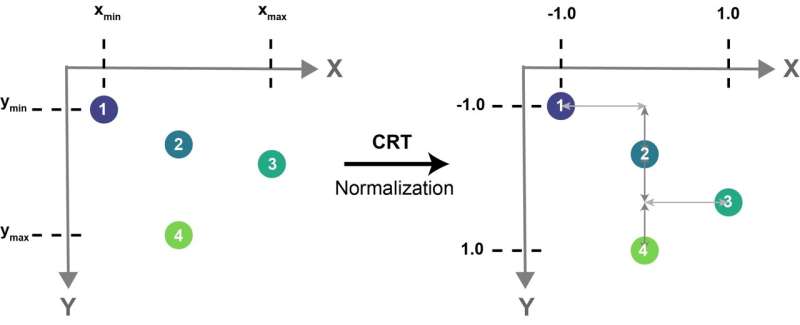This article has been reviewed according to Science X's editorial process and policies. Editors have highlighted the following attributes while ensuring the content's credibility:
fact-checked
peer-reviewed publication
trusted source
proofread
Coordinate-wise monotonic transformations enable privacy-preserving age estimation with 3D face point cloud
![Four elementary monotonic functions (exponential, logarithmic, square, and sine) were applied immediately after Coordinate-Wise Rank Transformation (CRT) and normalized to [-1, 1] in a coordinate-wise manner. The three circles on the radar plot correspond to the first-order Model Indistinguishability, the second-order Model Indistinguishability and the Mean Absolute Error of the exp(CRT) model (the largest among the four), from the inside out. All models could accurately and consistently estimate ages. Credit: Science China Press Coordinate-wise monotonic transformations enable privacy-preserving age estimation with 3D face point cloud](https://scx1.b-cdn.net/csz/news/800a/2024/coordinate-wise-monoto-1.jpg)
In a recent publication in Science China Life Sciences, a research team led by Professor Jing-Dong Jackie Han and Ph.D. student Xinyu Yang from Peking University established a deep learning model for age estimation using non-registered 3D face point clouds. They also proposed the coordinate-wise monotonic transformation algorithm to isolate age-related facial features from identifiable human faces.
The team trained the model on over 16,000 instances of 3D face point cloud data, achieving an average absolute error of about 2.5 years. The model recognizes the rotational invariance of human faces. In their analysis of face shape and skin tone's importance, they developed the coordinate-wise monotonic transformations algorithm.
The algorithm can distort faces without changing the relative positions of facial elements. The team found that the deep learning models could accurately and consistently estimate ages with faces before and after applying the transformation algorithm in various scenarios, demonstrating that the transformations effectively preserve age-related facial features.
However, in visual tests, subjects experienced a notable decrease in accuracy and response speed when assessing transformed faces. Additionally, computational face verification models trained on normal face shapes failed to recognize transformed faces.
Considering the similarities and differences in age estimation and identification tasks, the research team proposed a facial data protection guideline. This guideline, featuring coordinate-wise monotonic transformations and selective data provisioning, aims to provide a theoretical foundation for managing facial data centers or public datasets.

More information: Xinyu Yang et al, Coordinate-wise monotonic transformations enable privacy-preserving age estimation with 3D face point cloud, Science China Life Sciences (2024). DOI: 10.1007/s11427-023-2518-8


















